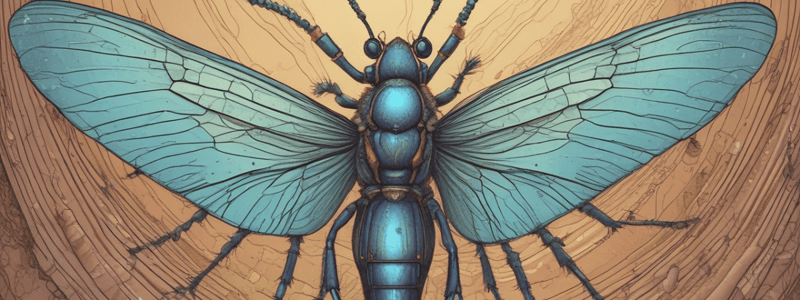Podcast
Questions and Answers
What is the purpose of ecdysis in ecdysozoans?
What is the purpose of ecdysis in ecdysozoans?
- To grow incrementally and facilitate changes between developmental stages (correct)
- To undergo metamorphosis
- To regenerate damaged tissue
- To develop a hardened cuticle
What is the outermost layer of the cuticle composed of?
What is the outermost layer of the cuticle composed of?
- Polysaccharides
- Protein
- Chitin
- Waxy, water-resistant material (correct)
What is the result of sclerotization in arthropods?
What is the result of sclerotization in arthropods?
- The cuticle becomes harder and more rigid (correct)
- The cuticle becomes softer and more flexible
- The cuticle becomes thicker
- The cuticle becomes more permeable to water
What is the function of the fine ducts in the cuticle?
What is the function of the fine ducts in the cuticle?
What is the primary function of the inactive enzymatic moulting fluid secreted during the moulting process?
What is the primary function of the inactive enzymatic moulting fluid secreted during the moulting process?
What is the process of ecdysis necessary for?
What is the process of ecdysis necessary for?
What is the term for the hardened plates formed through sclerotization?
What is the term for the hardened plates formed through sclerotization?
What is deposited on the surface of the epidermis during the third stage of the moulting process?
What is deposited on the surface of the epidermis during the third stage of the moulting process?
What happens to the digested materials from the old endocuticle during the moulting process?
What happens to the digested materials from the old endocuticle during the moulting process?
What type of enzymes are activated in the moulting fluid during the fourth stage of the moulting process?
What type of enzymes are activated in the moulting fluid during the fourth stage of the moulting process?
What occurs during the epidermis growth stage of the moulting process?
What occurs during the epidermis growth stage of the moulting process?
What is the purpose of the new procuticle layer deposited during the moulting process?
What is the purpose of the new procuticle layer deposited during the moulting process?
What is the primary function of the moulting fluid in ecdysozoans?
What is the primary function of the moulting fluid in ecdysozoans?
What is the sequence of events during ecdysis in ecdysozoans?
What is the sequence of events during ecdysis in ecdysozoans?
What happens to the surface area of the new cuticle after ecdysis?
What happens to the surface area of the new cuticle after ecdysis?
What is the function of the cuticle ducts in ecdysozoans?
What is the function of the cuticle ducts in ecdysozoans?
How long does sclerotization of the new cuticle take in ecdysozoans?
How long does sclerotization of the new cuticle take in ecdysozoans?
What is the characteristic shape of nematodes?
What is the characteristic shape of nematodes?
Flashcards are hidden until you start studying
Study Notes
Ecdysis in Ecdysozoans
- Ecdysis is essential for growth and development in ecdysozoans, allowing organisms to shed their exoskeleton and grow larger.
- The outermost layer of the cuticle is primarily composed of chitin, which provides structural support and protection.
- Sclerotization in arthropods results in the hardening of the cuticle, enhancing strength and durability.
- Fine ducts in the cuticle play a role in gas exchange and water regulation, facilitating physiological processes.
- The inactive enzymatic moulting fluid secreted during moulting assists in digesting the old cuticle for recycling nutrients.
Moulting Process
- Ecdysis is required for organismal growth, allowing for the replacement of old, restrictive cuticles with new ones.
- Hardened plates formed through sclerotization are referred to as sclerites, contributing to the rigidity of the exoskeleton.
- During the third stage of moult, new cuticle material is deposited on the epidermis, preparing for hardening.
- Digested materials from the old endocuticle are reabsorbed and utilized to support the growth of the new cuticle.
- Proteolytic enzymes in the moulting fluid are activated during the fourth stage, aiding in the breakdown of the old cuticle.
- The epidermis growth stage involves the expansion of the epidermal cells, leading to the formation of a new cuticle layer.
- The new procuticle layer is crucial for providing support and structural integrity before hardening occurs.
Functions and Changes
- The primary function of the moulting fluid in ecdysozoans is to facilitate the breakdown of the old exoskeleton and promote new cuticle formation.
- The sequence of events during ecdysis includes detachment of the old cuticle, secretion of new material, and eventual shedding.
- After ecdysis, the surface area of the new cuticle increases, enhancing the organism's ability to grow and function.
- Cuticle ducts help in metabolic exchanges, maintaining homeostasis within ecdysozoans.
- Sclerotization of the new cuticle typically takes hours to days, depending on the species and environmental factors.
- Nematodes exhibit a characteristic cylindrical shape, allowing for efficiency in movement and adaptation to their environments.
Studying That Suits You
Use AI to generate personalized quizzes and flashcards to suit your learning preferences.




